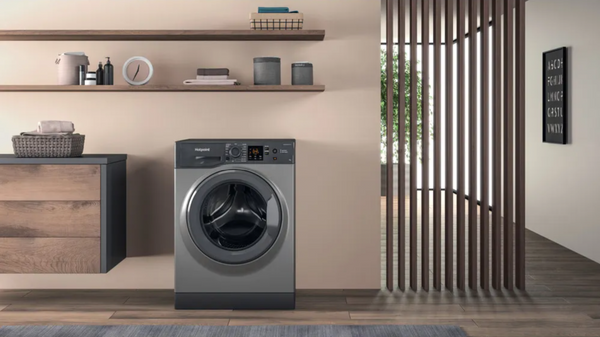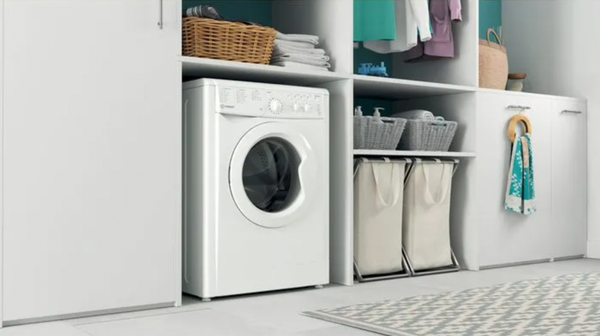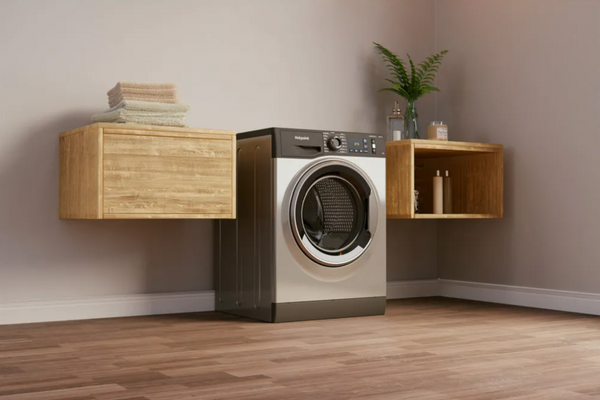Life is busier than ever these days—but you don’t need us to tell you that, right?
Between working, working out, and working on more quality time with friends and family, the last thing you need to add to your to-do list is worrying about your washing machine.
After a busy day, there’s nothing quite like putting on some clean comfy clothes and slipping into fresh bedsheets to unwind—but you need a trusty washing machine to rely on for these simple pleasures.
So, grab your favourite snack and settle in because we’re here with this ultimate guide from Comet on how long your washing machine should last and how to expand the lifespan of your washing machine.
How long does a washing machine last?
Unfortunately, there isn’t a simple one-size-fits-all answer to this question because how long a washing machine lasts depends on an array of different factors such as:
- How often it’s used.
- Quality of the product.
- How well it is cleaned and maintained.
- How it has been installed.
We’ll explore all of these topics in more detail, so keep scrolling to learn more about keeping your appliance in great condition.
However, as a rough guide, you should expect a washing machine to last an average of around 10 years or anything between 7–12 years.

Which lasts longer, a freestanding or integrated washing machine?
At this point, you might be wondering if a freestanding or integrated washing machine would be better and the answer is really all down to your personal preferences.
If you’re looking for something that is going to look subtle and sleek in a fitted kitchen or utility room, integrated machines definitely win when it comes to overall finish and aesthetic.
However, good quality, freestanding washing machines generally pip their integrated counterparts to the post when it comes to performance. This is simply because freestanding machines tend to have a larger capacity and faster spin speeds.
In terms of longevity, this really depends on how much you use your machine, the quality of the product, and how well you look after it.
That said, freestanding washing machines are a lot easier to maintain and repair because they are much easier to access than an integrated appliance.
How to make a washing machine last longer
How long your washing machine lasts will be partially down to the brand and quality of the product you buy.
However, there are a whole host of measures you can take to extend the lifespan of your machine and keep it in tip-top condition for much longer.
Below are 10 easy ways you can look after your washing machine and ensure stress-free spinning for as long as possible.
So, in no particular order…
Buy a high-quality washing machine
Investing in the best quality machines from the most reputable brands is one of the most effective ways to make sure your machine has a long lifespan.
If you go for a cheaper machine from a lesser-known manufacturer, there’s no saying it will last very long at all.
That’s not to say you have to completely blow your budget to get a washing machine you’ll be able to rely on. You can still get a fantastic Hotpoint washing machine or Indesit washing machine, for example, without having to max out on price point.
So, even if you can’t afford a top-of-the-range model with all the most sophisticated features, rest assured you can still get a great machine if you focus on reputable manufacturers and retailers (like us!).
Proper installation
Making sure your washing machine has been installed correctly is key to it having a long and happy life.
It needs to be fitted precisely to the manufacturer’s instructions so we’d always recommend getting a professional to do it for you. Not only will this ensure everything is done correctly, it will also save you a whole lot of time and hassle.
One of the main issues with ill-fitting washing machines is excessive vibration due to poor levelling.
A small amount of shaking during a spin cycle is totally normal. However, if the machine operates loudly enough to make your next-door neighbour’s dog bark, or it vibrates so much it rattles the mugs in your cupboard, you’ve got a levelling problem that needs sorting.
Leaving a washing machine to vibrate excessively will not only affect how it performs, it will also damage the drum and pipes attached to it over time.
Plus, if you’ve got an integrated washing machine, this can also cause some serious damage to units and flooring, which can become pretty costly to fix.
Learn how to clean a washing machine like a pro
Aside from buying a high-quality washing machine and having it installed correctly, you can also extend the life of your machine by regularly cleaning it. Below, we’ve set out some of our top washing machine cleaning tips.
Self-cleaning features
There are now a whole host of washing machine models that have built-in self-cleaning technology. However, not all machines will have this functionality, so it’s essential to stay on top of it yourself.
Pro tip: opt for a model that features an antimicrobial coating (this tends to be standard on most Hotpoint washing machines) to double down on combating grime, bacteria, and mould.
Manual cleaning
Routine cleaning of your appliance is key for keeping lint, detergent build-up, and mould at bay. All of these things will impact the day-to-day performance of your machine and can damage it in the long run.
You can buy washing machine cleaner from the supermarket, which is specifically formulated to clean washing machine drums and drawers.
Don’t forget to check vents, filters, and seals too. Clear away any lint and stray objects (e.g. coins, wrappers) and use an old toothbrush to clean away any gunky residue.
Important safety note: make sure to switch your machine off at the power outlet before draining or cleaning vents and filters! It’s also important to check the manufacturer’s instructions before using any cleaning agents.
Washing machine care tips
Sure, you can keep your washing machine nice and clean, but is there anything else you can do to ensure a long life span for it? Absolutely! Below, you’ll find the Comet team’s top washing machine care tips.
Don’t overload the drum
When you’ve let the laundry basket pile up, it can be tempting to stuff as many items into your washing machine as possible, we get it. However, overloading the machine can be extremely straining and damaging to the drum and other parts.
Overloading the machine also restricts how much the contents inside can move around, which can lead to a build-up of detergent and mould.
Stick to what the manufacturer recommends as the appropriate load size for your specific machine to reduce the risk of damage or malfunction.
To help consumers, some manufacturers fit their machines with load protection systems. These automatically detect the weight of the laundry load and - on many models - will actually prevent you from beginning a wash cycle until you’ve taken some laundry out of the drum.
Note - a good general rule is that once you’ve loaded the washing machine drum, you should be able to fit your hand above the laundry load with plenty of room to move it up and down. If you can’t do that, you’ve probably overloaded the machine!
Also, don’t forget to triple-check your pockets!
A rogue tissue in the pocket now and again shouldn’t do your machine too much harm but things like coins, small toys, and sharp objects can do significant damage. Just make sure all pockets are empty before you load up.
Keep the drum balanced
Overloading the drum is problematic but not putting enough washing in your machine can cause issues of its own. Putting just the right amount of washing in is what’s known by washing machine geeks (yes, they do exist) as a ‘balanced load’.
This means that the laundry can be distributed evenly around the drum so that imbalances don’t cause any strain or damage during the wash cycle.
Check out the settings on your machine—there may be specific cycle settings designed for lighter or heavier loads that you should use to protect it.
Having said all that, some manufacturers include load balancing software in their washing machines. This software detects the amount of laundry and automatically adjusts things like spin speed in order to protect the machine’s motor etc.
Regular machine maintenance
Regularly check all parts of your washing machine for any signs of wear or damage. This includes things like seals, filters, and hoses.
Giving them all a regular once-over means you’ll be able to spot any problems quickly and have them repaired before they threaten the lifespan of your washing machine.
Of course, wear and tear is inevitable and eventually, it will be more cost-effective to treat yourself to a new machine. However, with attentive maintenance and careful use, this should only be happening many, many years down the line.
Use the right type of detergent
Consult your manufacturer’s instructions to find out what type of detergent and other washing products you should be using and exactly how much.
Using the wrong products can cause strain on your machine, impacting performance and lifespan.
More product might make your laundry smell stronger, but it may also leave residue in your washing machine drum and drawer, leading to more build-up, mould, and unpleasant odour over time.
Empty the drum promptly
Doesn’t it always feel like the cycle finishes and the washing machine starts beeping at the most inconvenient of times? It can be tempting to leave the wet washing in there for a while and come back to it later (we’ve all done it), but this won’t do your machine any good.
Remove the clean laundry as soon as the cycle ends (or as soon as possible) and then leave the washing machine door and detergent drawer open for a few hours to dry and air out.
Doing this will keep dampness and mould at bay, both of which can cut the lifespan of your washing machine short if you let them.
Leave repairs to the professionals
If and when you do find that your washing machine needs a repair, act quickly and enlist the expertise of a technician who knows exactly what they’re doing.
If you attempt to do the repairs yourself, you run the risk of making costly mistakes and causing even more damage. It can also be very dangerous and will almost certainly void the manufacturer’s warranty (should the machine still be under warranty).
DIY can seem like a tempting option when you want something done fast or want to save a bit of cash but hiring a professional will save you time and money in the long run.
Be aware of hard water
Do you live in an area of the UK that has ‘hard water’ (where the water contains a high volume of dissolved minerals such as magnesium calcium)?
Then you may want to increase your washing machine cleaning schedule slightly. Hard water can sometimes lead to the accumulation of a residue within the washing machine drum once it has dried following a cycle.

Is the myth about moving washing machines true?
Many people are scared to move their washing machines - if they’re moving house, for example - for fear of it completely breaking in transit. While there is some truth in transportation being risky for a washing machine, it’s not impossible to move one from A to B safely.
If you don’t take the necessary precautions and move your washing machine with care, it can significantly damage the suspension and the function of the drum. You also run the risk of cracking the plastic, smashing the glass door, or misplacing parts if you aren’t super careful.
However, relocating your washing machine safely can be a breeze. Below are five easy steps that will help ensure you move your washing machine as securely as possible:
Read the manual and/or manufacturer’s guidelines
Not all washing machines are the same - check out the manual or manufacturer’s instructions for advice on how to safely manoeuvre it from one place to another.
You’ll find guidelines here about what can be detached and what needs to stay attached, and whether or not you need to take specific steps once you reinstall the machine.
Many manufacturers supply their washing machines with ‘transit bolts’. These bolts are used to secure the washing drum and prevent it from rotating, vibrating and generally moving around whilst the washing machine is in transit. Keep a hold of these so that you can reuse should you need to move home in the future.
Top tip: if you can’t find your manual anywhere, you’ll almost always be able to track down a digital version to download online.
Disconnect and store the hoses carefully
Whatever needs disconnecting for transportation, like pipes or hoses, make sure to do so carefully. Once they’re disconnected, ensure they are safely stored in a location where A) you’ll remember where they are (!), and B) where they won’t be at risk of damage.
Leaving hoses dangling from the appliance while you transport it is a dangerous tripping hazard, but it’s also a one-way ticket to having to fork out for replacement parts.
Use tape and padding to protect all parts of the machine
Before you move the machine, tape the door and drawers into place to secure them while it’s in transit. Tape the power cable to the machine too so that this doesn’t get snagged or pulled off in the move. You could even use shrink wrap for extra security.
Wrap the whole appliance in multiple sheets or furniture blankets to protect it against knocks, scratches and dents, too.
Stand upright and move using an appliance trolley
Once the machine is all taped, wrapped up, and ready to move, attach it to an appliance trolley with wheels and secure it tightly in place. Ratchet straps or bungee cords with hooks are generally the best way of securing an appliance to a trolley.
Make sure to stand the washing machine upright because lying it on its back or side can damage its suspension, cause parts to come loose, and create issues with alignment.
Run an empty cycle once you have reinstalled the machine
Once your washing machine is situated in its new home, run a test cycle with no washing or detergent to check everything has been installed and connected correctly. That way, you don’t risk damaging the drum or destroying any of your laundry in the process.
Top tip: get a professional to reinstall your washing machine for you to save you the added pressure and to ensure all pipes and pieces are present and correct.
Following these five steps will prolong the life of your washing machine and mean you never have to stress about it during a big house move ever again.

Choose quality, choose Comet
Hopefully you’ve found our guide on how long a washing machine should last helpful and that you’re feeling more clued-up on how to make your appliance last a lot longer.
But, sometimes you just need to buy a new washing machine. If so, you’re in the right place…
We don’t only stock washing machines from some of the leading brands on the market, but we also offer flexible finance options to make it easy to find the perfect washing machine for you.
You can use Klarna Pay in 3 or PayPal Credit to spread the cost of your brand-new washing machine over three, interest-free payments.
So, whether you’re buying new or looking to replace an old machine, Comet has got you covered.
Shop washing machines at Comet now and learn more about our delivery options.
For more buying guides, advice, and information, explore the Comet blog...











